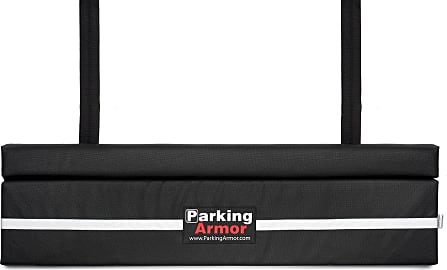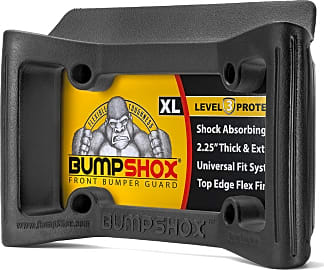The 8 Best Bumper Guards

This wiki has been updated 34 times since it was first published in October of 2016. Car bumpers are vulnerable and tend to collect scratches, dents, and dings. It's easy to nudge into another vehicle on busy city streets or packed parking lots, but that doesn't have to mean a costly repair job. These guards are designed to protect your car's extremities from low-impact collisions with other vehicles and stationary objects. Note they do not protect against structural damage. When users buy our independently chosen editorial choices, we may earn commissions to help fund the Wiki.
Editor's Notes
April 08, 2020:
Removed the Protekt Guard because of availability issues.
Added the BumpTek Flexi Guard and the BumperSafe 98.
There are many great bumper guards out there that can protect against scratches and chips that result from very low-force impacts. None of them are meant to protect from structural damage or really any damage that would normally be caused by an accident of significant force. So even relatively low-force impacts that would result in, for example, caving in a bumper's corner, or cracking the plastic, would not be mitigated by any of these guards - not even the thick 2-inch padding on the Parking Armor 4.8 helps with anything stronger than a slow bump or swipe. This is evidenced by the fact that the Parking Armor 4.8 is only designed to be used while parking. They could have easily added side straps to make it usable during driving but they recognize that it's effectiveness on impacts of the magnitude that moving cars are subjected to is very limited. The Luv-Tap BG001 can be used while driving, which adds the benefit of protection from scuffs during parallel parking.
A Brief History Of Bumpers
The 1968 Pontiac GTO was a groundbreaking car in terms of bumper design.
Bumpers are a relatively new invention, as there was little need for them before cars came along. After all, bumping into someone on horseback did little more than scare the horse.
The first bumper was made in 1897 by a Czech automaker, Nesselsdorfer Wagenbau-Fabriksgesellschaft. While it was made of metal, it served no purpose other than for decoration.
About four years later, a rubber model was invented by Frederick Simms. This one was intended to absorb impact, but it failed to catch on.
By the mid-1910s, however, many automakers were including bumpers as optional accessories. These were mainly just strips of steel across the front and back of the car. However, they must have been popular with early drivers, as they soon became more commonplace and complex.
When the 1950s rolled around, car culture was such a dominant force in America that virtually every part of the automobile was seen as a form of personal expression, including bumpers. They went from simple collision-dampening devices to elaborate chrome works of art, and just about every American manufacturer took pains to distinguish their bumpers from those of their competitors.
The following decade saw the rise of lighter chrome models, designed to give the cars a more modern feel. These bumpers were constructed in such a way as to incorporate grills, lighting, and exhaust systems, further expanding their usefulness.
The 1968 Pontiac GTO was a groundbreaking car in terms of bumper design. Not only did it incorporate a new, loop bumper that was painted to match the body color, but it also used Endura plastic that was capable of handling low-speed impact with little or no damage.
The government began getting involved in bumper design in the 1970s, as Congress passed regulations requiring that they be able to withstand a 5 mph collision with no damage. Automakers responded by ditching the sleek, attractive Endura plastic models and going back to bulky, ugly chrome behemoths.
Today, most bumpers are made of plastic or polycarbonate materials and placed over a reinforcement bar made of steel, fiberglass, aluminum, or plastic. They're extremely light and well-cushioned, improving both fuel efficiency and safety. Many carmakers have even tried to replicate the old-school chrome look without sacrificing the modern advantages of plastic.
Benefits Of A Bumper Guard
Your bumper is there to protect your car in the event of a collision, so it might seem silly to buy an accessory designed to protect your bumper. Isn't that like putting a hat on a hat?
Well...yeah, but that doesn't mean it isn't a good idea, especially if you care about your car's appearance.
So yes, you may feel like having a guard is a little redundant — but we bet you won't be complaining when having one saves you from taking a trip to the body shop.
Since bumpers are intended to minimize the impact passengers feel during a collision, they're designed to absorb that impact themselves. This means that they can crumple in even the slightest accident, and they can be expensive to fix.
A bumper guard, however, can help dissipate the impact before it ever reaches your bumper, taking the brunt of the collision and protecting your car. This comes in handy, especially since guards are significantly cheaper than new bumpers, and much easier to replace without issue.
Now, that doesn't mean that you can get in a head-on collision at high speeds and come out of it with a spotless bumper. They're mainly designed for low-speed situations, such as backing into a wall, or accidentally giving another car a love tap at a stoplight, and they can save you from having to bust out the slide hammer.
Still, they can help reduce whiplash in minor fender benders, so they do offer a useful safety function in addition to their aesthetic role.
So yes, you may feel like having a guard is a little redundant — but we bet you won't be complaining when having one saves you from taking a trip to the body shop.
Easy Ways To Protect Your Bumper
There's no more damning indictment of your driving ability than having a dented, wrecked bumper, so here are a few ways to prevent that from ever happening.
Oh, and stay far away from that shopping cart return as well.
Obviously, you should observe established safety standards. That means following at a safe distance when you're on the road, and paying close attention to your surroundings when parking or pulling out of a space. You should take care to notice potential hazards when you first enter a parking lot, and possibly even consider investing in a backup camera.
Of course, you're not the only driver you have to worry about. Many people use their bumpers as guides when parallel parking, so to avoid having yours damaged, try to pick the first or last spot on the street. This should at least guarantee that one of your bumpers is immune to damage.
In parking lots and garages, you can take spaces farther away from the entrance to the building. This is less convenient for you, but if you're parked on an island all alone, there's less chance someone will feel the need to back into you. Oh, and stay far away from that shopping cart return as well.
If you tend to hit the wall in your garage when you park, hang a tennis ball from the ceiling at a point where it will hit your car before your car hits the house. This is a cheap and easy way to protect both your bumper and your humble abode.
Ultimately, though, there's likely nothing you can do to completely protect your bumper, so resign yourself to the fact that it will get damaged eventually. Or you can sit outside with a baseball bat and watch over your car at all hours of the day. Both are probably equally healthy.













